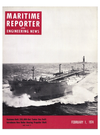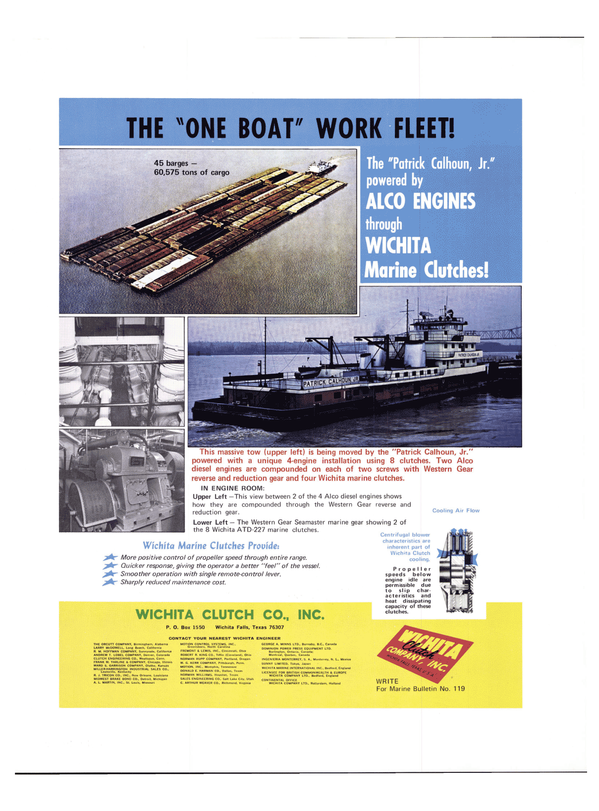
Bethlehem Begins Construction On 265,000-Dwt Tanker —Largest Vessel Built In The United States
Construction of the largest ship ever built in the United States started on January 23 as Bethlehem Steel's Sparrows Point Shipyard laid the first keel plate for a 265,000-dwt supertanker.
The vessel, the first of five under contract at the yard, is scheduled for delivery to Boston- VLCC Tankers, Inc., II, in 1975. All five ships are being constructed under the U.S. Maritime Administration's tanker construction subsidy program arising out of the 1970 Merchant Marine Act.
Boston-VLOC Tankers, Inc., II, IV and VI, subsidiaries of First National Boston Corporation, have contracted for the first three of the huge vessels and, upon completion of their construction, they will be placed on long-term charter. First National Boston Corporation is a registered multi-bank holding company whose principal subsidiary is the First National Bank of Boston.
This class of ships, the 10th standard design offered by Bethlehem since World War II, will be 1,100 feet overall, with a breadth of 178 feet, and a summer' freeboard draft of 67 feet 1 inch.
The keel was laid in the yard's new 1,200- foot graving dock, in which a 120,000-dwt tanker is already under construction.
The huge new tanker, capable of carrying 2,035,000 (barrels of oil, is designed to exceed the largest safety and antipollution requirements.
The arrangement of the vessel has been specifically designed to meet the 1973 international Convention for the Prevention of Pollution from Ships, concerning cargo tank size and maximum outflow. This results in 21 tanks (two of which are for clean ballast), as compared with the smaller number of tanks in the usual VLCC of today.
The vessel will be fitted with an inert gas system, which maintains a nonexplosive atmosphere within the cargo tanks at all times.
A modern improved load-on-top (LOT) system for handling tank cleaning slops, including fixed tank cleaning in all center cargo tanks, is also provided.
The single-screw vessel will have a single deck with forecastle, a cylindrical bow and a transom stern. The hull will be about 80 percent mild steel and 20 percent higher strength steel.
The aft superstructure incorporates all living and messing spaces, appropriate utility spaces and the navigation and control spaces. The layout of accommodations is based on a complement of 28. All staterooms are single occupancy with semiprivate toilets and showers for the crew, private toilets and showers for officers.
All living spaces are air-conditioned.
Lifeboats have been located for embarkation from a platform one deck height above the upper deck.
Deck machinery will include 12 mooring winches of a unique type that have been developed to Bethlehem's specifications for tanker service. When the hydraulic system is in operation, they are automatic pull-in/payout type with selective dual ratings of line pull of 30.000 pounds or 60,000 pounds. When the hydraulic system is not in operation, they will automatically pay out at a prescribed predetermined maximum line pull.
Propulsion is provided by a cross compound, single flow steam turbine, driving the propeller shaft through a double reduction gear. An astern element is incorporated in the low pressure turbine casing. The maximum continuous ahead rating is 35,000 shaft horsepower at 85 rpm.
Cargo is handled by means of four large 20,000-gpm turbine-driven horizontal singlestage centrifugal pumps with added selfpriming features. Steam requirement for the cargo pumps is virtually the same as for propelling the ship at maximum power. Each pump normally handles its own group of tanks but may be cross-connected to other groups. A steam reciprocating pump is provided for stripping purposes, together with a deck stripping main. Nominal pump-out time is about 18 hours.
A clean ballast pump of 10,000-gpm capacity is provided to handle the No. 4 wing tanks and the after deep tanks through a segregated system.
The J.J. Henry Co., Inc. was designated by the owners to act in their behalf in dealing with Bethlehem in all matters concerning design, approvals, changes and inspections.
Read Bethlehem Begins Construction On 265,000-Dwt Tanker —Largest Vessel Built In The United States in Pdf, Flash or Html5 edition of February 1974 Maritime Reporter
Other stories from February 1974 issue
Content
- Shipyard Marketing Conference Planned page: 4
- Cordon International To Supply Equipment For Three LNG Ships page: 6
- Sixth VLCC Delivered By Kockums To Salen Features Roller Bearing Design For Shaft page: 7
- Admiral Payne To Succeed Admiral Brockett At Webb page: 7
- NASSCO Launches Largest Vessel Ever Built On West Coast page: 7
- Walter Thorsen, Inc. Named Exclusive Rep For Eleusis Shipyards page: 8
- Ogden Marine, Inc. Buys Two Tankers page: 10
- Oceans International Announces Merger And Expansion Plans page: 10
- Aluminum Tanks And LNG Ship Steel Hulls To Be Joined By Using Du Pont Detacouple Explosion Bonded Welding Transition Joints page: 11
- McAllister Orders Three 4,290-Hp Tugs page: 11
- Delta SS Awards Contract To Equitable For 50 LASH Barges page: 12
- Bethlehem Begins Construction On 265,000-Dwt Tanker —Largest Vessel Built In The United States page: 12
- Arthur Levy Boat Service Announces New Appointments For Thomas And LeBlanc page: 12
- Greek Committee Established By Det norske Veritas page: 13
- Esso Norway Test Of Hull Structure Proves Design And Good Workmanship page: 14
- Todd President Sees U.S. Shipbuilders Improving Competitive Position page: 14
- Society Of Marine Port Engineers N.Y. Discuss Care Of Turbine And Hydraulic Oil Systems page: 14
- Harwich Tonnage, Inc. Formed In California page: 15
- K.W. Waldorf Named To New Zapata Post page: 15
- Bigger, Bigger . . . Bigger page: 18
- USMMA At Kings Point To Admit Women page: 19
- Storm Awards Contract To Bethlehem Beaumont Shipyard For Offshore Drilling Rig page: 20
- NASSCO Expanding Facilities To Build 150,000-Ton Tankers page: 20
- NASSCO Delivers S/S Coronado— First Of Three For Margate Shipping page: 21
- SNAME N.Y. Metropolitan Section Hears Technical Paper On 'New Approach To The Ship Hull Characteristics Problem' page: 21
- ASNE Annual Meeting Set For May 2-3 In Washington, D.C. page: 21
- Experimental LNG Carrier Will Evaluate Two Tank Systems Under Operating Conditions page: 24
- International Ship Suppliers To Meet In Washington, D.C. September 22-26 page: 24
- Thomas B. Crowley Elected President At Western Shipbuilding Ass'n Annual Meeting page: 24
- Whitehouse To Head ABStech Regional Office In Houston page: 25
- Colt Industries Names Nidenberg page: 25
- FMD Appoints Sanchez To Direct Field Operations page: 25
- Alco Engines Names Comeng Holdings Ltd. Australian Licensee page: 25
- Magnavox Announces New Integrated Navigation System page: 28
- Friede & Goldman Inc. Design Zapata Rigs Building At Avondale page: 28
- Sea Trials And Launching Ceremonies Held For AMOCO Tankers At Astilleros Espanoles page: 28
- Halter Delivers New York Pilot Boat page: 29
- Ametco Shipping Elects J.E. Hundt President page: 29
- World Dredging Ass'n New Midwest Chapter To Meet February 28 page: 29
- Wiley And Clyde Iron Now Division Of AMCA Int'l —AMCA Sales $100 Million page: 30
- Kaiser To Build LNG Tanks For Oceangoing Ships On Pinto Island In Mobile Bay page: 30
- Eleusis Shipyards Launches Largest Vessel Built In Greece page: 31
- Paclines To Carry Cargo California To Hawaii Using Tug And Superbarge page: 31
- L. Arthur Strenkert Named Sales Manager Smit Nymegen Corp. page: 31
- Magnavox Announces Offshore Drill Rig Positioning System page: 31
- Paul J. Evanson Appointed Controller Moore And McCormack page: 32
- Paper On Water jet Propulsion Discussed During SNAME Philadelphia Section Meeting page: 32
- Mainland China Places Order Worth $2 Million For Rucker Petroleum Drilling Equipment page: 33
- Pittsburgh-Des Moines Orders Large Quantity Of Aluminum For LNG Ship And Land Use page: 33
- Worthington Service Corp. Names Budrick And lennings page: 33
- Zapata Corporation Reports Record Results page: 33
- Drew Chemical Names Rogers Managing Director New So. Africa Subsidiary page: 33
- Luckenbach To Build New Tampa Terminal page: 33
- SNAME Players Perform At Pacific Northwest Section's 27th Annual Fall Meeting page: 33
- Japanese Firm Buys Lawson Products Corp. —John Gaydos Named page: 34
- David O'Neil To Head New Firm Of Marine Propulsion Consultants page: 34
- Liberian Services —Consulting Firm Elects Wiswall Pres. page: 35
- Diamond M Orders Two Jackup Rigs And A Semisubmersible page: 35
- New Marine Systems Brochure From Waukesha Motor page: 36
- Management Changes At Dearborn-Storm page: 36
- Tanker Management Firm Promotes Nichols page: 36
- DOD Management Of Energy Resources Highlights Naval Engineers Meeting page: 37
- Raytheon Company Submarine Signal Div. Appoints R.G. Popovici page: 38
- Berwind Lines Names Bericochea Exec. VP page: 38
- Selective Calling System Saves Time For Oceangoing Tankers And River Vessels page: 40
- Storehouse Of Information Readily Available From ABS Using Computerized Retrieval page: 42


